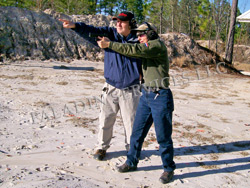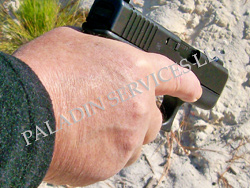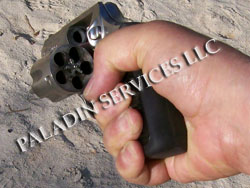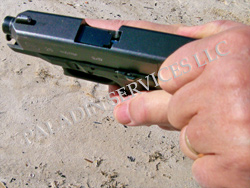|
|
 |
NRA gun safety rules
The fundamental NRA rules for safe gun handling are:
 |
 |
1. ALWAYS keep the gun
pointed in a safe direction.
This
is the primary rule of gun safety. A safe direction
means that the gun is pointed so that even if it
were to go off it would not cause injury or damage.
The key to this rule is to control where the muzzle
or front end of the barrel is pointed at all times.
Common sense dictates the safest direction, depending
on different circumstances. |
| |
|
|
 |
|
2. ALWAYS keep your finger
off the trigger until ready to shoot.
When holding a gun, rest your finger on the trigger
guard or along the side of the gun. Until you are
actually ready to fire, do not touch the trigger. |
| |
|
|
 |
|
3. ALWAYS keep the gun
unloaded until ready to use.
Whenever
you pick up a gun, immediately engage the safety
device if possible, and, if the gun has a magazine,
remove it before opening the action and looking
into the chamber(s) which should be clear of ammunition.
If you do not know how to open the action or inspect
the chamber(s), leave the gun alone and get help
from someone who does. |

|
|
|
NRA Rules When Using or Storing a
Gun
When using or storing a gun,
always follow these NRA rules:
- Know your target and
what is beyond.
Be absolutely
sure you have identified your target beyond
any doubt. Equally important, be aware of the
area beyond your target. This means observing
your prospective area of fire before you shoot.
Never fire in a direction in which there are
people or any other potential for mishap. Think
first. Shoot second.
- Know how to use the
gun safely.
Before handling a
gun, learn how it operates. Know its basic parts,
how to safely open and close the action and
remove any ammunition from the gun or magazine.
Remember, a gun's mechanical safety device is
never foolproof. Nothing can ever replace safe
gun handling.
- Be sure the gun is safe
to operate.
Just like other tools,
guns need regular maintenance to remain operable.
Regular cleaning and proper storage are a part
of the gun's general upkeep. If there is any
question concerning a gun's ability to function,
a knowledgeable gunsmith should look at it.
- Use only the correct
ammunition for your gun.
Only
BBs, pellets, cartridges or shells designed
for a particular gun can be fired safely in
that gun. Most guns have the ammunition type
stamped on the barrel. Ammunition can be identified
by information printed on the box and sometimes
stamped on the cartridge. Do not shoot the gun
unless you know you have the proper ammunition.
- Wear eye and ear protection
as appropriate.
Guns are loud
and the noise can cause hearing damage. They
can also emit debris and hot gas that could
cause eye injury. For these reasons, shooting
glasses and hearing protectors should be worn
by shooters and spectators.
- Never use alcohol or
over-the-counter, prescription or other drugs
before or while shooting.
Alcohol,
as well as any other substance likely to impair
normal mental or physical bodily functions,
must not be used before or while handling or
shooting guns.
- Store guns so they are
not accessible to unauthorized persons.
Many factors must be considered when deciding
where and how to store guns. A person's particular
situation will be a major part of the consideration.
Dozens of gun storage devices, as well as locking
devices that attach directly to the gun, are
available. However, mechanical locking devices,
like the mechanical safeties built into guns,
can fail and should not be used as a substitute
for safe gun handling and the observance of
all gun safety rules.
- Be aware that certain
types of guns and many shooting activities require
additional safety precautions.
- Cleaning
Regular cleaning is important in order for your
gun to operate correctly and safely. Taking
proper care of it will also maintain its value
and extend its life. Your gun should be cleaned
every time that it is used.
A gun brought out of prolonged storage should
also be cleaned before shooting. Accumulated
moisture and dirt, or solidified grease and
oil, can prevent the gun from operating properly.
Before cleaning your gun, make absolutely
sure that it is unloaded. The gun's action
should be open during the cleaning process.
Also, be sure that no ammunition is present
in the cleaning area.
|
Holders of Concealed Weapons Permits
in South Carolina are expected to know
SLED's (the South
Carolina Law Enforcement Division's) gun safety
rules too.
For safety's sake and the
benefit of our students we explain both sets of
safety rules in our classes. We also give each student
in every class a printed copy of both the
NRA gun safety rules and the SLED gun safety rules
to keep for future reference. We're serious about
safety. |
Email us about taking a class or personal training with
us. Please be sure to include your local telephone number(s)
so we can call to determine your needs and answer your questions.
Top of Page
|